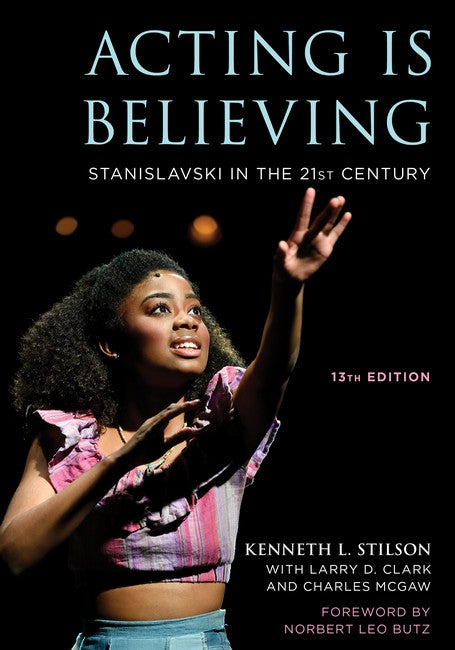Kenneth L. Stilson is the author of the last five editions of Acting is Believing, along with the late Larry D. Clark and the late Charles McGaw. Stilson serves as the Executive Director of the Lanford Wilson New American Play Festival and Founding Chair of The Jeanine Larson Dobbins Conservatory of Theatre & Dance at Southeast Missouri State University. As a playwright/librettist, his works include An American Hero: A World War II Musical (OB, Acorn Theatre, NYMF, winner, Best of Festival), Stage Door Johnny: A Rock Musical (with Mike Appel), Where the Lilies Grow, and more. His screenplays include Fire Lily (Best of Festival, American Artist Film Festival) and Interviewing Monsters (with Tom Greene), and he is the author of Ezra Stone: A Theatre Biography. He has been an acting coach for 30 years, with former students having earned Tony and Obie Awards. He has directed more than 70 plays and musicals at numerous theatres. He currently serves on the Commission of Accreditation with the National Association of Schools of Theatre (NAST) in Arlington, VA.
Request Academic Copy
Please copy the ISBN for submitting review copy form
Description
Foreword by Norbert Leo Butz Preface Acknowledgments Chapter 1A: Life in Art Acting with Professional Competence The Six Parts of Actor Training The Business of Acting Acting is Believing: Stanislavski in the 21st Century External Resources Chapter 2: The Creative State Body Training Breathing and Posture Exercise 2.1 Breathing Exercise 2.2 Posture The Creative State Exercise 2.3 Aerobic Exercise 2.4 Stretching Exercise 2.5 Moving Exercise 2.6 Vocalizing On Anxiety Physical Tension Social Inhibitions Nudity and Intimacy Chapter 3: The Choice of Actions Exercise 3.1 Given Circumstances and Imagination Commitment to Actions Belief in Actions Improvisational Technique Exercise 3.2 Improvising Simple Tasks Exercise 3.3 Recalling a Special Memory Scoring Physical Actions Tempo/Rhythm Exercise 3.4 Scores from Scenarios Chapter 4: Stanislavski's Method of Physical Actions Simple Objectives Exercise 4.1 Refining Your Score Action Verbs Exercise 4.2 Actions from an Emotional State Exercise 4.3 Everyday Actions Physical and Psychological Obstacles Strategy and Desire Expectations and Adaptations Nonverbal Group Improvisations Exercise 4.4 Waiting Exercise 4.5 Not on Speaking Terms Verbal Group Improvisations Exercise 4.6 Opposing Objectives Exercise 4.7 Improvisation from Action Verbs Exercise 4.8 Non-Content Scenes Chapter 5: Observation Exercise 5.1 Playing a Condition Exercise 5.2 Three Objects Exercise 5.3 Adjusting to Conditions Observing People Exercise 5.4 Observation Notebook Exercise 5.5 Creating an Actor's Image Collage Adapting Your Observations Exercise 5.6 Observing Visual Art Abstraction Exercise 5.7 Abstractions from Inanimate Objects Exercise 5.8 Abstraction from Animals Chapter 6: Circles of Attention Exercise 6.1 Distractions Exercise 6.2 Add-a-Word Public Solitude The Small Circle Exercise 6.3 Objects in the Small Circle Communion Exercise 6.4 Mirrors Exercise 6.5 Silent Argument Communion with the Audience Dramatic Action in Speech Exercise 6.6 Key Line Improvisation Chapter 7: Emotion Memory Stanislavski and Emotion Memory Retaining an Emotion Memory Selecting the Emotion Memory Using the Emotion Memory Emotional Triggers Exercise 7.1 Reconstructing a Personal Memory Inner Images Exercise 7.2 Verbalizing Images Exercise 7.3 Image Improvisations Inner Monologues Exercise 7.4 Inner Monologues Chapter 8: Creating a Character Script Analysis The World of the Play Exercise 8.1 Historical Imagination Character Autobiography Exercise 8.2 Character Autobiography Exercise 8.3 If It Were Up to Me... Second Plan Exercise 8.4 Second Plan External Expression Units of Action Scoring Exercise 8.5 Scoring a Role The Motivating Force Exercise 8.6 Motivating Force The Super-Objective Exercise 8.7 Super-Objective Summary Chapter 9: Subtext Exercise 9.1 Improvising Subtext Verbal Action Exercise 9.2 Text, Subtext, and Verbal Action Relating the Lines to the Motivating Force Relating the Lines to the Super-Objective Manners of Speaking Dialects and Accents Exercise 9.4 Speech Patterns Longer Speeches Exercise 9.5 Verbal Actions in Longer Speeches Chapter 10: The Power of Words Meaning, Operative Words, and Idioms Sentence Structure Progressions Antithesis Secondary Inner Images Exercise 10.1 Longer Speeches Chapter 11: Reincarnation Tablework and Early Discoveries Working Rehearsals Exercise 11.1 Putting Spontaneity into Physical Choices Run-throughs and Technical Rehearsals Performances Chapter 12: The Business of Acting Understanding the Business Business Plan Exercise 12.1 The Actor's Business Plan Exercise 12.2 The Elevator Pitch Headshots and Resumes Exercise 12.3 Resume Introductory and Follow-up Emails Exercise 12.4 Introductory and Follow-up Emails Preparing Your Audition Exercise 12.5 Audition Preparation - Working Off a Partner Auditioning Exercise 12.6 Moment Before Exercise 12.7 Laughing at the Top Exercise 12.8 Portfolio Appendix A: Self-Directed Scene Study Appendix B: Glossary Bibliography Index

